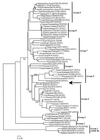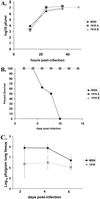Sequence of the 1918 pandemic influenza virus nonstructural gene (NS) segment and characterization of recombinant viruses bearing the 1918 NS genes
- PMID: 11226311
- PMCID: PMC30210
- DOI: 10.1073/pnas.031575198
Sequence of the 1918 pandemic influenza virus nonstructural gene (NS) segment and characterization of recombinant viruses bearing the 1918 NS genes
Abstract
The influenza A virus pandemic of 1918-1919 resulted in an estimated 20-40 million deaths worldwide. The hemagglutinin and neuraminidase sequences of the 1918 virus were previously determined. We here report the sequence of the A/Brevig Mission/1/18 (H1N1) virus nonstructural (NS) segment encoding two proteins, NS1 and nuclear export protein. Phylogenetically, these genes appear to be close to the common ancestor of subsequent human and classical swine strain NS genes. Recently, the influenza A virus NS1 protein was shown to be a type I IFN antagonist that plays an important role in viral pathogenesis. By using the recently developed technique of generating influenza A viruses entirely from cloned cDNAs, the hypothesis that the 1918 virus NS1 gene played a role in virulence was tested in a mouse model. In a BSL3+ laboratory, viruses were generated that possessed either the 1918 NS1 gene alone or the entire 1918 NS segment in a background of influenza A/WSN/33 (H1N1), a mouse-adapted virus derived from a human influenza strain first isolated in 1933. These 1918 NS viruses replicated well in tissue culture but were attenuated in mice as compared with the isogenic control viruses. This attenuation in mice may be related to the human origin of the 1918 NS1 gene. These results suggest that interaction of the NS1 protein with host-cell factors plays a significant role in viral pathogenesis.
Figures





Comment in
-
H1N1-influenza as Lazarus: genomic resurrection from the tomb of an unknown.Proc Natl Acad Sci U S A. 2001 Feb 27;98(5):2115-6. doi: 10.1073/pnas.051000798. Proc Natl Acad Sci U S A. 2001. PMID: 11226198 Free PMC article. No abstract available.
References
-
- Crosby A. America's Forgotten Pandemic. Cambridge, U.K.: Cambridge Univ. Press; 1989.
-
- United States Department of Commerce. Historical Statistics in the United States: Colonial Times to 1970. U.S. Govt. Printing Office; 1976. p. 58.
-
- Rafi A, Spigelman M, Stanford J, Lemma E, Donoghue H, Zias J. Lancet. 1994;343:1360–1361. - PubMed
Publication types
MeSH terms
Substances
Associated data
- Actions
LinkOut - more resources
Full Text Sources
Other Literature Sources
Medical
Miscellaneous

